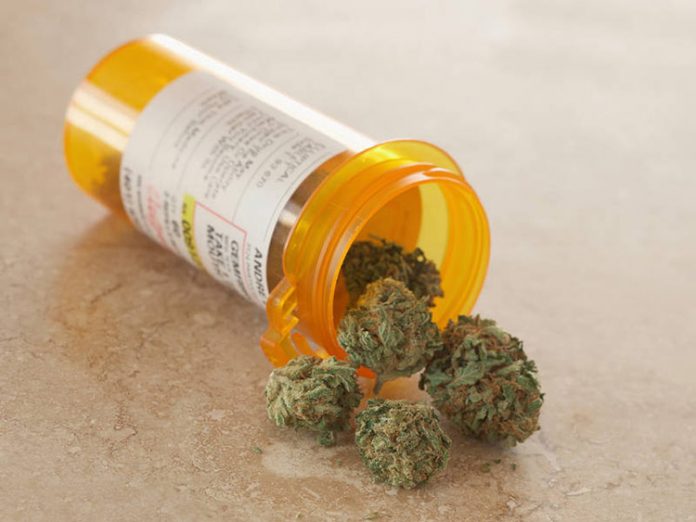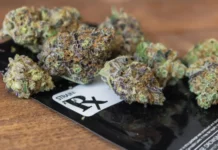When Sylvie Lammert had her first seizure at nine months old, she was rushed to an emergency room where doctors couldn’t find an apparent cause. It would be the first of five seizures she had that day.
During the last seizure, it took medical personnel 30 minutes before they could bring the baby’s tiny, convulsing body under control. And it would be years before doctors could diagnose Lammert’s debilitating condition — later determined to be a rare form of epilepsy known as Dravet syndrome — and even longer before they found a medication that could help.
Eventually, she was enrolled in a trial on Epidiolex, a cannabis-based oil made by U.K.-based GW Pharmaceuticals (GWPH). The drug, which contains the chemical cannabidiol, or CBD, has made a world of difference for Lammert and could do the same for drugmakers now experimenting in cannabis-based treatments.
“The first thing we noticed when she started to take the CBD oil was that she had a lot more clarity in her thinking and in her processing,” Lammert’s mother, Kathleen Corkins, said in an interview with Investor’s Business Daily. “She has the ability to express herself. She is much less fatigued and her seizures came under control.”
Small biotech firms like GW, Insys Therapeutics and Zynerba Pharmaceuticals are looking to cash in on the green source that up until recently was considered taboo. In June, it’s likely GW Pharma’s Epidiolex will become the first to cross the finish line with an approved treatment derived from cannabis plants.
Potential Blockbuster?
Epidiolex is on track to become a blockbuster, according to research firm Clarivate Analytics, while other analysts will say only that it might reach that status. Clarivate lists Epidiolex among a dozen drugs expected to launch in 2018 and become blockbusters in five years. In 2022, it sees Epidiolex generating $1.19 billion in sales.
Its likely approval also could stoke interest among Big Pharma and biotechs looking to get an early jump in the cannabis market, says Dan Ahrens, portfolio manager for AdvisorShares Investments’ Vice exchange-traded fund. The fund focuses on the alcohol, cannabis and tobacco markets.
“You could almost call that a first mover,” Ahrens said in an interview. “When you get someone approved, a lot of other biotech and pharma companies want to get in on the action. It could cause additional interest or movement in the space.”
GW derives the CBD in Epidiolex directly from the cannabis plant. CBD is non-psychoactive, so it doesn’t carry the same side effects associated with marijuana.
This differs from approved drugs by AbbVie and Insys, which contain the chemical tetrahydrocannabinol, or THC, and are created in a lab. THC is the chemical responsible for marijuana’s euphoric high.
CBD In Seizures
If approved, Epidiolex would be the first medicine that specifically treats Dravet syndrome. GW, which operates as Greenwich Biosciences in the U.S., also is testing or seeking approval for Epidiolex to treat other conditions.
Epidiolex can be taken with other seizure medicines. For instance, Lammert still takes a trio of anti-seizure medications, though Corkins notes her daughter is now taking lower doses.
GW began pivoting its cannabis research to seizure disorders based on the high unmet need in that market, Stephen Schultz, vice president of investor relations, said in an interview. The firm has been working in cannabis for two decades.
“With both of these conditions, the seizures are uncontrolled,” Schultz said. “It’s not uncommon, especially for Dravet patients, to pass away, generally in their sleep. So the more you can reduce the convulsive seizures, certainly one would assume the better the prospects for that patient.”
Late Diagnosis
Lammert wasn’t diagnosed with Dravet syndrome until she was a preteen. It’s a rare form of epilepsy that begins in the first year of an infant’s life. Children with Dravet often have developmental disabilities.
“Back in the day, there would be times when it would be hard for her to get out of bed,” Corkins said. “She would go to school and they would call me at 11 to come get her. When she was tired, she would have more seizures.”
The science was still relatively immature when Lammert got her diagnosis. In the ensuing years, Lammert tried countless drugs to control her seizures, Corkins said. She had a device implanted in a critical nerve, and removed when it didn’t work. She also tried a special diet.
Now 21, Lammert lives in Lincoln, Mass, and attends a school for those with special needs in nearby Lexington. She works in a library and a garden center, and also plays on a basketball team. In May, she’s planning to attend a school prom.
Lammert still has seizures, but they are much less frequent and less severe, Corkins says. In the past, Lammert had seizures where she would lose consciousness and/or drop suddenly. For a year, she wore a helmet to prevent injuries due to the sudden onset of seizures.
“It was a huge roller coaster, we never knew when she would have one,” Corkins said.
GW Results Positive
A Phase 3 study unveiled in January showed the benefit of Epidiolex in Lennox-Gastaut, another epileptic disorder. Patients ages two to 55 who suffered a median of 74 drop seizures per month took Epidiolex for two weeks. Those patients saw a 44% reduction in the episodes.
The firm also tested Epidiolex in Dravet patients ages two to 18, with a median 13 convulsive seizures per month. Patients added Epidiolex to their standard drugs for two weeks. These patients saw a median 39% decline in convulsive seizures.
Schultz emphasizes Epidiolex’s difference from CBD sold at dispensaries in states like California and Arizona where medical marijuana is legal. Epidiolex is clinically tested at specific, consistent levels. Doctors know how it will interact with other medications, he said.
“It does not vary, which is a real problem with artisanal, dispensary-based products,” he said.
Also, Epidiolex will likely be covered by insurance companies if the FDA approves it.
“In our trials, patients were taking a gram, 1.5 grams, up to 2 grams of CBD per day,” he said. “If you find 1.5 grams of CBD (from a dispensary), that’s going to be very expensive.”
Rivals Gear Up
GW also is testing Epidiolex for a genetic disorder characterized by noncancerous tumors and infantile spasms. Outside the U.S., another GW drug called Sativex treats spasticity in multiple sclerosis patients. Sativex contains both CBD and THC, as well as other chemicals found in the cannabis plant.
So far, GW remains in a class of its own in cannabis. Insys and Zynerba are working on synthetic CBD drugs. Insys also sells Syndros, which is similar to AbbVie’s Marinol. Both contain the THC chemical found in cannabis, but create it synthetically.
Insys is also studying CBD in a form of epilepsy, infantile spasms and a genetic condition called Prader-Willi syndrome. Further, the firm is doing preclinical work for THC treatments in anorexia associated with cancer and agitation in Alzheimer’s disease.
Zynerba is researching the use of CBD and THC in several rare disorders including some seizure conditions, Tourette’s syndrome and a genetic condition called Fragile X syndrome. At the same time, Cara Therapeutics is looking at drugs that interact with the cannabinoid receptors in the brain.
GW must work with the Drug Enforcement Agency to legally handle cannabis. The DEA lists it as a Schedule I drug, which has no currently accepted medical use and a high potential for abuse. Firms must invest in a robust program and prepare for “a very intense regulatory protocol,” GW’s Schultz said.
“It does take special skill and special care,” he said. “We’re very excited about the work we’re doing here. This is hopefully going to be a very transformative year with the launch of our first drug in the U.S. and the first plant-derived cannabidiol medicine.”
Before that, GW will speak on Thursday before a special advisory committee of the FDA, which will decide whether to recommend Epidiolex to the full agency.
Analysts Sound Off
Analysts are excited about the prospects for Epidiolex and other CBD drugs, plant-derived or synthetic. In a February report to clients, Leerink analyst Paul Matteis noted patient enthusiasm is growing.
A neurologist speaking at a recent panel said not a day goes by that a patient or physician doesn’t reach out with a question regarding CBD drugs. He called the excitement “unprecedented,” Matteis said.
“The neurologist questions whether or not Epidiolex can realistically live up to the cannabidiol hype over time,” Matteis wrote. “However, he envisions it garnering wide use and emphasizes the high level of awareness heading into the launch.”
Dr. Jacqueline French, a professor at NYU Langone Health medical center and chief scientific officer of The Epilepsy Foundation, says there is now “indisputable evidence” that CBD has a beneficial impact on seizures. She notes no clinical studies have borne out data on the impact of THC on seizures.
But the CBD hype comes with a few caveats, she said in an interview. Like other medications, it has risks including sleepiness when mixed with some other drugs. It can also cause an upset stomach and diarrhea.
“It’s like any other intervention and new therapy,” she said. “We can be very excited about it. But this is a drug, like other drugs. It has side effects. You have to do some monitoring of the body chemistry. But that doesn’t make it less exciting. It just means you have to treat it like a drug.”
A Natural Remedy?
Patients see Epidiolex as a natural remedy, she said. Lammert’s mother shares that opinion.
Lammert went through a “dramatic change” when she began taking CBD oil, Corkins said, though she acknowledges Lammert is also older now and there are other factors that could have eased her seizures.
“Basically, any seizure medicine that was available between 1998 and 2010, Sylvie probably tried,” Corkins said. All of it was to little avail until Lammert enrolled in a study of Epidiolex at New York University several years ago.
Lammert’s doctor works with French at NYU’s Comprehensive Epilepsy Center and has treated her since she was about 3 years old. Corkins understands the societal stigma attached to CBD medications, but says it wasn’t a difficult choice to enroll Lammert in the study.
“I think when you’re at the point you’ve used all your options and your loved ones are struggling, and you have the chance to try a CBD oil, I guess it was an easy choice for me,” she said. “It’s super purified and I feel like it comes from a natural substance.”














